I Want To Write A Book But Don’t Know How To Get Started?
Well, we all have once thought about writing a book after reading J.K Rowling’s fantasy masterpiece “Harry Potter” or Sidney Sheldon’s “The Other Side of Midnight?”
But writing a book isn’t as simple as sitting on the comfy couch in your living room, grabbing the pen and paper, and boom! You’ve carved the next literary masterpiece of the world.
So, what’s actually the secret formula to crack your creative side and write a book that will keep your audience hooked from the beginning till the end? Well, there’s no unique cheat sheet through which you can walk on the lucrative path to authorship.
For some, the gentle hum of a quiet room and the aroma of a freshly brewed cup of coffee creates the perfect atmosphere for writing, while other find their creative powers awakened amidst the embrace of nature.
In this blog post, learn the art of writing a literary masterpiece and becoming the next big author. So, let’s get started.
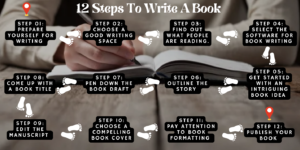
12 Steps To Write A Book
As book writing guide is an extensive topic, we have divided this process into three sections;
Step 01:Pre-Planning Phase
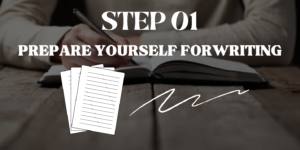
1. Prepare Yourself For Writing
Writing a book is no less an art, and turning an ordinary art into an exceptional masterpiece takes time, dedication, and hard work. It takes nothing to idolize a renowned bestselling author like Stephen King or Octavia Butler. However, every individual has a unique story of starting as an ordinary person and overcoming challenges to reach their current position.
For instance:
Octavia E. Butler juggled multiple jobs to support herself while dedicating early mornings to writing. Undeterred, she penned success mantras to fuel her determination.

Stephen King worked various jobs as a janitor and gas pump attendant. After the rejection of his first novel, Carrie, by 30 publishers, he discarded the manuscript but later found success with its publication, launching his illustrious writing career.
So, what have we learned?
The first step to learning book writing is understanding how to overcome writer’s block, deal with self-doubts, and put yourself in a productive mind frame to help you achieve your goals.
You can work on these two practices to overcome obstacles and crush challenges to keep you directed towards achieving your goal- writing a book.
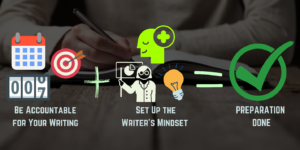
1a. Be Accountable For Your Writing
Do you only write when you have nothing else to do? If yes, you can’t become a successful author and reap name and fame in the writing world. It’s not a good practice to write only when you feel inspired.
Approach your writing with the same commitment as a job or responsibility. Hold yourself accountable, take consistent action, and show up daily to make progress.
- Benchmark A Writing Goal. If you don’t set an attainable goal, there’s a high chance that procrastination can take you over. Before starting off, set the writing goal, including establishing a writing objective, defining the number of writing sessions per week and setting a specific target date for completing various sections of your book.
- Designate Time Slots For Writing On A Weekly Basis. To initiate this practice, allocate one to two hours per day, five days a week. Consistently engaging in writing sessions will foster a habit, ultimately making it easier to prioritize and accommodate writing in your schedule.
- Set A Daily Word Count. Determine the word count you want to achieve every week. You can also utilize any online word count calculation tool to set a suitable target based on the genre or type of book you are working on.For instance, if you’ve decided to write 5000 words in 6 days of the week, then you’ve to write approximately 840 words each day to attain your weekly goal.
1b. Set Up The Writer’s Mindset
Obviously, we are talking about book writing, but what does it mean to set up the writer’s mindset?
Well, that doesn’t mean that you need to recite a specific mantra to transport yourself to another world of book writing or give you the superpower to write perfectly everything that comes into your mind.
Many inspirational authors stay stuck in the middle of the plot because of their mindset, which prohibits them from coming up with something creative.
Here’s how to set up your mindset as a writer;
- Accept Yourself. To be a successful writer, you have to acknowledge all your self-doubts and don’t let negative thoughts let your morale down. It’s okay to feel discouraged, but these feelings shouldn’t stop you from penning down what you like. Instead of considering writing as a challenge, accept it as a learning process.
- Take Inspiration. If you ever feel like giving up, take inspiration from the fact that, just like you, numerous creative gurus and successful authors started from the bottom. You can also motivate yourself by researching and reading about your favorite authors and their journey toward success.
- Be Positive. There’s no lie in the saying that your thoughts have a great impact on your capabilities. It’s essential to use optimistic affirmation to elevate yourself, or you can also read inspirational quotes and lines for motivation.
- Seek Guidance From Experts. Sharing your goals with others can also serve as a source of motivation, encouraging you to strive for greater achievements and ensuring that you take responsibility for your work.
Additionally, seeking out experienced writers or professionals within your circle can provide valuable mentorship.
Engaging in conversations with them about your endeavors, progress, and writing challenges can lead to fresh perspectives and improved solutions, ultimately enhancing your writing style.

2. Choose A Good Writing Space
Choosing a perfect spot where you can lean back and pen down your manuscript is as important as choosing the right title for the book.
Yes! You heard it right.
Your surroundings and where you sit have a great influence on what you write.
But it’s not necessary that this perfect writing spot should be in your home. If you don’t find the motivation to write in your home, you can go for other options like a coffee shop, a co-working space, a library, a park, or any other place where you can write your best.
Working from home is the best option, but it may be a hurdle if you have kids or family members around or simply don’t have any assigned room in your home.
The truth is that the ideal writing environment is unique and subjective to every individual. We all give our best in different environments. Maybe experienced writers can pen down their best in co-working spaces, and one who is new to writing prefers to work in a calm environment.
If you don’t know which one is the best for you, we suggest you experiment to find out the best setting where you can write freely with focus.
How does an ideal writing space look like?
Try working in different locations to determine in which setting you can give your best. It’s possible that you’ll find yourself tapping into your creativity more effectively by periodically changing your writing environment.
Here are some valuable pointers to help you establish an atmosphere that fosters concentration and boosts your writing output:
- Opt for noise-canceling headphones to create a peaceful environment that aids concentration.
- Maintain a tidy workspace, as clutter can serve as a source of procrastination, especially when chores are involved.
- Minimize distractions by ensuring there are no enticing elements around that might divert your attention from writing. Consider turning off your phone to avoid interruptions from others.
- Personalize your writing environment to foster a pleasant atmosphere. Add posters and plants to your home office or establish a consistent writing spot at your favorite café, creating a dedicated space exclusively for writing.

3. Find Out What People Are Reading
Before writing a book, it is essential to conduct market research on Amazon to identify the most popular books in your genre. Keep in mind that if you want your book to thrive, you must compete with these bestsellers. To do this, go to the Amazon Best Sellers page and locate your genre using the left-hand sidebar.
Next, analyze the blurbs of those books to discern the key selling points. Identify common elements that make them appealing to readers. Evaluate whether your book meets these criteria.
Lastly, brainstorm how your book can bring something fresh and unique to the table. Consider what innovative aspects or perspectives it can offer to stand out from the existing competition.
For instance, if you’re planning to write an adventurous story, determine whether your story will feature a daring and resourceful protagonist who embarks on thrilling journeys or a series of unexpected twists that keep the reader engaged and eager for more.
In today’s hyper-competitive market, pushing the boundaries is essential to give your book a real shot at success. So, don’t skimp on conducting extensive research within your genre before starting writing.
This will provide valuable insights into the standards you need to meet and how you can surpass them to make your book shine in the teeming market.
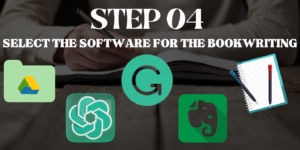
4. Select The Software For Book Writing
After the revolution of the internet, nothing has remained the same. Not even the book writing!
It all started in 1882 when Mark Twain sent his first manuscript to the publisher that had been written on the leaf of technology, a typewriter, which ultimately transformed the entire writing industry.
Fast forward, now in 2023, we have numerous advanced tools and applications to carve the best piece of writing for the readers.
From novice word processing software to thousands of AI tools, we have access to almost everything around the world. You can get your hands-on endless book writing applications that can assist you in becoming a renowned name in the industry.
Instead of confusing you by entailing different applications available on the internet, below is the list of four free online tools that we recommend to all potential writers to add to their writing toolkit today.
Instead of overwhelming you with all the possible apps in existence, below is a list of five tools I recommend adding to your writing toolkit today (and they’re free).
4a. Google Drive
- Enable you to organize your project by creating dedicated folders for different aspects such as research, outline, manuscript drafts, and more.
- Make use of Google Docs as a word processor, and take advantage of the templates specifically designed for book writing.
- Utilize Google Drive to store and manage files related to your projects, including images and photos.
- Access your files from various devices, including laptops, smartphones, tablets, and more.
- Google Drive offers versatile cloud storage capabilities beyond its primary function. Here’s a list of ways you can leverage Google Drive to enhance your book writing process.
- Easily collaborate with others, avoiding any issues with version control.
- Benefit from 15GB of free storage upon signing up.
- Explore resources to master the use of Google Drive (If you have a Gmail account, you already have a Google Drive account).
4b. Chat GPT
Since its debut in November 2022, Chat GPT has brought about significant transformations in the digital marketplace.
While the premium version of Chat GPT unlocks its full potential, the free version remains an invaluable resource for gaining basic insights and grasping the essence of various topics.
- Chat GPT (Free Version) can generate creative ideas, overcome writer’s block, and brainstorm potential plotlines, characters, or themes for your book.
- You can ask this AI tool for feedback on your book’s concepts, plot twists, or character development. It can offer suggestions and fresh perspectives to enhance your writing.
- If you have specific research questions related to your book, Chat GPT can help provide clarifications or point you in the right direction, acting as a quick reference tool.
- Seek assistance from Chat GPT to refine your writing style, improve sentence structure, or find alternative words or phrases. It can provide suggestions to make your book more engaging and polished.
- Chat GPT can also provide tips on pacing, dialogue, or effective storytelling techniques. It can offer guidance to enhance the overall quality of your book.
- If you’re stuck on a particular plot point or facing challenges in the narrative flow, Chat GPT can help you brainstorm solutions and overcome obstacles.
- You can use Chat GPT to quickly find basic information or facts relevant to your book, such as historical events, geographical details, or scientific concepts.
4c. Grammarly
Grammarly offers a free version of its editing tool that provides valuable assistance in enhancing your writing.
With this version, you can improve your grammar, punctuation, and spelling, as well as receive suggestions for sentence structure and word choice.
It scans your text for errors, highlights them, and offers alternative corrections, helping you avoid embarrassing mistakes.
Additionally, Grammarly provides explanations for its suggestions, helping you learn from your errors and become a better writer over time.
While the free version offers significant benefits, Grammarly also offers a premium subscription with advanced features such as plagiarism detection, style improvements, and vocabulary enhancement, further enhancing the quality of your writing.
4d. Evernote
Evernote proves to be an invaluable tool for book writers. With its versatile features, you can easily gather and organize your research materials, outline chapters, and jot down plot ideas on the go.
The ability to sync across devices, including Google Docs, ensures that your work is always accessible and up-to-date.
Whether you’re a professional author or an aspiring writer, Evernote provides the essential support to streamline your book writing process and bring your literary visions to life.
4e. A Notebook & Pen
Don’t underestimate the power of using pen and paper for writing a book. It’s unarguably the most important writing tool, even in 2023.
Even if you use a writing software program for your entire manuscript, it’s still important to have a notebook on hand for those moments when inspiration hits, and you don’t have access to a computer.
Every writer should keep a notebook handy for capturing random ideas and thoughts. You can quickly write them down in your notebook and later transfer them to your digital writing software when you’re back at your computer.
Step 02.Book Writing Phase
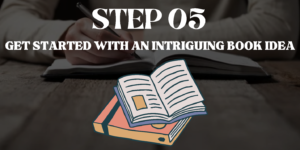
5. Get Started With An Intriguing Book Idea
After doing all the pre-planning, the next phase is coming up with an engaging idea for your book. If you don’t have one, you won’t be able to write more than a few lines.
That means everything starts with an idea.
So, what’s your idea?
Perhaps you have a clear vision of what you want to write about, or maybe your mind is filled with numerous ideas, but you’re unsure where to begin.
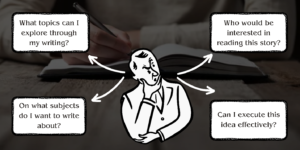
If you don’t have one, you can come up with one by questioning yourself on these grounds;
- On what subjects do I want to write about?
- What topics can I explore through my writing?
- Who would be interested in reading this story?
- Can I execute this idea effectively?
By considering and responding to these questions, you can narrow down your choices to determine the most suitable options for you.
Whether you’re crafting a practical non-fiction guide or weaving a captivating post-apocalyptic thriller, it’s crucial to establish a connection with your audience, and one effective way to achieve that is through evoking emotions. To truly resonate with your readers, it’s essential to gain a deep understanding of them.
For instance: The scenario where you find yourself with numerous book ideas, yet there’s only one that genuinely ignites your passion and confidence. That very idea becomes your premise.
On the other hand, if you find yourself devoid of ideas, the questions mentioned questions will guide you towards a more definite path. Focus on the genres and books that captivate you, those that have left a profound imprint on your being. Chances are, you’ll write a book within a similar realm.
By focusing on these four factors, you can determine better what you want to write and how to do it more clearly;

5a. Write About Things That Interest You
Find a title that ignites your curiosity, a topic that entices you to return consistently, or come up with something that captures your deep interest, a subject in which you are fully engaged.
If you’ve chosen something that doesn’t interest you or just because it’s trending and everybody is talking about it, there are very few chances that you can write something that can appeal to your readers.
Choose a topic that sustains your motivation even during periods of zero inspiration or when faced with writer’s block. Your chosen subject should be the one that propels you forward and keeps you committed to the creative process.
5b. Identify Your Target Audience
Another key factor that will impact your topic choice is your targeted reader. One effective approach is to develop a reader persona, a partially fictional representation of your ideal audience.
This persona serves as a guiding archetype, helping you tailor your content to resonate with and engage your intended readership.
To embark on the journey of crafting your reader persona, start by answering the following questions;
- Readers’ Age: Identify what age group you’re going to target. Are you writing a rom-com for teenagers or guides for industry beginners and experts? By determining the age group, you can set the writing tone and context of the book.
- Education Level: Determine at what level of education your reader is. Are you writing a psychology book for reading enthusiasts or a textbook for high-school passouts? By doing this, you can better gauge writing verbiage, style, and word choice to be used in the content.
- Reader’s Interest: Find out what topics will interest your readers. When authoring a book, prioritize what your reader needs to know rather than solely focusing on what you want to convey. Maintain a reader-centric approach throughout the process of brainstorming your topic and composing your book.
- Visual Representation: Does your reader like to see the visual representation of what you want to convey? If you’re writing a children’s book, adding intriguing images and illustrations will aid in attracting little readers, and if you’re writing a business book, readers will expect visuals like charts, graphs, photographs, tables, and diagrams.
Long story short, the more you try to understand readers, the better writing you can deliver to them.
5c. Choose Topics On Which You Can Immediately Write
The process of writing and completing a book is no less than a life-long experience for any author. There will come a time when you are able to write at your best, but there may also be instances when you find yourself struggling with a particular topic. If you’re unsure of where to start, it’s advisable, to begin with the topic you are most knowledgeable about. We recommend selecting a title that allows you to write quickly and efficiently, even with limited resources.
Let’s explore some ways to discover a topic on which you can write immediately;
- Life Experiences: Not everybody has a similar story, and their life experiences aren’t the same either. Each person has had some life experiences that have changed them into the person they are today. In your book, you can share your own experiences with the world and assist those who are in the same situation as you.
- Life Lesson: You can get started writing on the topics that you’ve experienced in your real life. What distinctive insights have you gained about the world? Consider the lessons you’ve learned through personal experiences and contemplate how your newfound knowledge can benefit others in society.
5d. Research Potential Topics
In this tech era, finding a relevant topic for your book has now become a matter of just a few clicks.
Write a keyword or idea on the search bar and Ta-Da! You got thousands of suggestions for your new book.
Search engines like Google and Bing have now made it easier to research any topic.
But wait! Do you have too many ideas for your book? You can also skim and scan each one to determine its scope.
Let’s find out some of the ways through which you can research the book idea on Google;
Check out the content that has already been written in other books of the same genre.
- Do someone has already worked on this idea?
- Is there anything included in the content that has increased the readers’ knowledge?
- How does their book perform in the market?
- What do you need to add to your knowledge?
- Are there any well-known authors who have written content on this topic?
- What new piece of information do you find in their books?
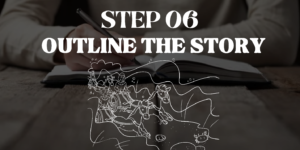
6. Outline The Story
Just like architects come up with blueprints before constructing any building to visualize its appearance upon project completion, creating a remarkable story requires the development of a flawless outline.
If you want to pen down an interesting story, you must have an intriguing outline in hand first. Having a solid blueprint is particularly crucial, especially for first-time authors, as it serves as a reliable guide to navigate through challenging moments when writer’s block inevitably strikes. (And trust us, it will.)
Let’s find out how we can create a book outline that you can use as a map to seamlessly write a complete book.

6a. Come Up With A Mind Map
Once you grasp an idea, now is the time to implement what’s on your mind. With a perfect mind map for your book, you can better drill down into its sub-topics.
Here’s how you can list down ideas for your book;
- Grab a pen and paper
- Set a 10 to 15-minute timer based on your writing speed.
- Write the main idea in the center of the page.
- Pen down all ideas, purposes, and objectives related to the book’s topic.
- Continue writing until the timer stops.
After idea mind mapping, you’ll definitely have a page full of brainstormed concepts, ideas, and thoughts. Review your writing and start organizing it according to your priority or book flow. These pointers will help you a lot when you start writing content for the book outline.
6b. Pen Down A Purpose Statement
Try to define the book’s purpose in a sentence or two. A compelling purpose statement will clarify to readers the reasons they should contemplate reading your book.
Additionally, this will aid in maintaining focus as you embark on drafting your outline and writing your book and prevent you from deviating into unrelated topics or going off on tangents.
6c. Create A Preliminary Outline For Your Book
Finally, it’s time to draft a working outline for your book. But remember, it’s just a basic task; this outline may vary throughout the writing procedure, and that’s perfect.
Commence by integrating the sub-topics and ideas you’ve noted in your mind map into your book’s outline.
Your outline will prove invaluable once you begin writing. It can effectively combat writer’s block and boost your writing momentum and productivity. Instead of pondering what to write in the next chapter of your book, you’ll already have a clear starting point from your book’s outline.
6d. Fill In The Writing Potholes With Extensive Research
Once you’ve finished your working outline, it becomes crucial to conduct further research on your topic. This step will enable you to fill in any gaps or areas you might have missed or overlooked in your initial outline.
Ensure a balance between research and writing. Dedicate time to research, but avoid becoming overly absorbed in it, as it could impact your book writing journey.
Here’s how you can research while writing a book;
- Utilize online resources through a comprehensive Google search on your chosen topic.
- Read other books that have been written about your subject matter.
- Listen to expert interviews, podcasts, and audiobooks that pertain to your area of interest.
- Delve into scholarly articles and academic journals within the relevant subject or industry.
- Explore archives, collections, historical journals, data records, and newspaper clippings to gain clarity on events, dates, and facts, especially when writing about historical topics.
6e. Guidelines For Crafting Your Book
Adopting a framework for your book can significantly facilitate keeping your writing organized and relevant.
Selecting a format or structure that aligns with your book’s topic will prove invaluable in creating a cohesive outline, and streamlining the writing process for each chapter.
These are things you should keep in mind while writing your outline.
- Choose The Right Format: You can choose from among different types of book outlines that include but are not limited to the free-flowing mind map, character-based outline, and chapter-and-scene outline. If one approach is not going with your writing style, try another.
- Pay Attention To Conflict Points: Determine the areas where you are feeling stuck or facing issues in seamlessly transfusing your ideas into words. Work on these areas first. However, it’s not necessary to have a precise understanding of where the conflict will emerge; it is important to have a solid understanding of how it will work within your book.
- Have A Well-Defined Start, Middle, And End: Many authors make the mistake of having a clear idea of how their story should begin but neglecting to develop a cohesive middle and a satisfying ending. While writing a book outline, pay proper attention to flesh out these crucial sections and establish meaningful connections between them.
6f. Frameworks
Within the vast landscape of Book Writing, there exist numerous molds into which you can shape your book. However, here are some of the preferred frameworks, specifically suited for non-fiction writing, that you may consider when starting your book-writing journey:
- Reference: You can go for this framework if your book is intended to serve as a user-friendly reference, facilitating readers in locating the information they need quickly.
- Sequential: This framework is the best if you’re going to write “How to” with a particular set of instructions and methodologies.
- Three-Act Structure: You can employ this framework if you’re going to entail a story in your book with three main parts, including the initial set-up, Rising Action, and the final Resolution.
- Modular: Utilize this framework if you have a substantial amount of information or concepts that can be organized into related topics but do not necessarily require a specific sequential presentation.
- Problem and Solution: This framework works best when it is vital for readers to easily identify a problem and comprehend the corresponding solution.
- Compare And Contrast: Choose this framework if you aim to demonstrate to your readers the similarities or differences between two or more ideas or concepts.
- Chronological: If every section of your book corresponds to a specific chronological time or order of events, this framework is perfect for you.
- Combination: If your book aligns with two or more of the above-mentioned frameworks, you can adopt a combination framework tailored to suit your book’s specific topic.
Step 03: Final Touch-Up Phase

7. Pen Down The Book Draft
After passing through all the preliminary planning stages, generating ideas through brainstorming, and crafting a detailed outline, now is the time to step into the real battlefield; writing down the first book draft.
Being first-time authors, we understand that it’s difficult to come up with perfect plots and ideas in one go, but Rome wasn’t built in a day.
Several novice writers believe that writing a compelling masterpiece is all about awe-inspiring verbiage, figurative language, and intricately woven sentences.
But that’s not true!
If that’s the case, “To Kill a Mockingbird” by Harper Lee won’t become a bestseller in 1960. Even this is the book that has been loved by readers to this date.
However, the style holds great importance; subject matter is far more essential in book writing. That means; paying attention to tone and vocabulary but plot, character, themes, and climax should be your primary priority.

7a. Come Up With An Intriguing Opening Sentence
But, sometimes, writers face difficulty not in writing an intriguing introduction that keeps the reader on the tip of their toes but an end that leaves a lasting impression lingering in the reader’s mind long after they have turned the final page.
Crafting a satisfying conclusion that ties together all the narrative threads and delivers a powerful message can be a formidable challenge.
Let’s find out some of the most reliable tips that you can follow to complete your book;
With the book’s outline and chosen framework at hand, you are all set to start writing your first manuscript.
When you focus on the bigger picture of book writing, there’s a huge possibility that you might get overwhelmed in the early stages of writing.
Here are some of the ways through which you can better breakdown your book writing into smaller sections;
- Start By Writing One Chapter At A Time. Rather than attempting to write all the chapters in one go, focus your attention on a single section at a time. By doing this, you can enhance your writing skills and create a more cohesive and engaging narrative.
- Establish Deadlines For Completing The Writing Segment. Divide your overall goal into smaller sections, and assign specific deadlines for accomplishing each individual section.
- Set Writing Time: Writing a book requires dedicated time and undivided attention. To write a book that bespoke your ideas, assigs a particular writing time that includes research and review time. That means if you’re dedicating 3 hours to book writing, you can give 45 minutes for critical review and 45 minutes to research required for the book and then dedicate the rest of the time to writing.
Alternatively, if you choose to divide your writing time into three separate periods throughout the day, you can allocate your dedicated hours as follows:
- Morning: Reserve 45 minutes to review and refine what you’ve written.
- Evening: dedicate 45 minutes for research and additional insights gathering.
- Night: Spend the remaining 90 minutes focusing on the writing process.
Celebrate Small Achievements: Small victories lead to big wins! That’s why we suggest you celebrate every milestone you achieve in book writing, no matter how small or big it is. Be it going out for dinner, treating yourself with coffee and cookies, buying yourself a fancy pan, or anything else you love.
7b. Buckle Up Your Shoes To Complete Your Book
Creatively penning down something is not a walk in the park, and when it comes to book writing, the situation becomes even more challenging.
We don’t promise that your book writing journey will be without challenges, nor do we guarantee that with our tips, you’ll complete a 260-page book within a mere month.
There will also come a time when you may encounter moments of writer’s block. Even when you have a clear idea of what you should be writing, there will be times when the words sound amiss as you reread and assess your work in your mind.
But don’t worry! That’s normal!
We have bought some tips that can help you fight with creative block and speed up your writing process;
Avoid Editing While Writing: Editing and writing are two different skill sets that require you to work in two different mind frames. It’ll slow down your writing pace and make you stop at different points.
So, Write First And Edit Later.
Don’t stress if your initial writing isn’t flawless; the primary goal is to express your thoughts. You can polish and refine your words during the editing process.
- Take Breaks: While writing, it’s completely normal to feel burnout. Take breaks while writing and get back to it when you feel right. But small breaks mean just a day or two off, not a month or two.
- Look For Creative Inspiration. Sometimes it’s kind of frustrating to do just nothing but write, write, and write in your leisure time. If you feel tired of this activity, you can read a novel, binge-watch your favorite show, visit an art gallery, or do what you love. It will greatly revitalize your creative mindset and give you new ideas on which you can write in your book.
- Switch Your Writing Space: Consider revitalizing your writing environment if you typically write at home in your own space. Experiment with writing in a public park, coffee shop, or library, especially on days when writing seems unappealing. This change of scenery might inspire your creativity.
- Pen Down Something Other Than Writing. Immersing ourselves too deeply in a book’s topic can become restricting sometimes. If you find yourself losing enthusiasm for writing about your book, consider exercising your writing muscles in a different discipline. Engage in creative writing exercises, keep a journal, or try composing a poem to explore new avenues of expression.
7c. Craft A Book That’s Pure Thrill And No Frills
Writing a book is no less than a challenge, especially when you reach a section with vague outlines. Yes, it looks tempting to add excessive words and fancy techniques to fill the page. However, that’s just filler content. If you add too much of it in your book, readers may get frustrated and perceive you as trying too hard to impress.
Outlining is one of the effective ways to do it, but here are a few more tips through which you can outstand your storyline;
- Pay Close Attention To Your Pacing. When the story moves too slowly, it could be a sign of excessive description. If it feels like the events are dragging along, you might be focusing too much on style and not giving enough attention to the plot.
- Every Sentence Depicts Some Action. Each sentence must serve one of two purposes: to unveil the character or move the story forward.
Kurt Vonnegut says that if a sentence fails to achieve either of these objectives, consider removing it. If the passage remains coherent and meaningful, then it’s best to let it go.
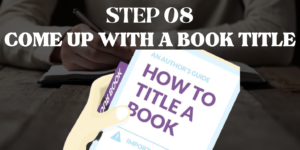
8. Come Up With A Book Title
The words that matter the most for your book are the ones gracing the outside cover.
Your Book Title!
If 90% of your target audience reads your book’s title, there are chances that 25% will buy and read your book. Given this, it becomes crucial to invest additional effort in crafting an emotionally compelling and impactful title.
Create a title that not only sticks in the minds of readers but also vividly portrays the genre and storyline of your book. Make it easy for potential readers to recall and be intrigued by what your book has to offer.
Prepare a comprehensive list comprising ideally 25 or more titles. This abundance of options will offer you the freedom to mix and match, enabling you to discover the perfect title that captures the essence of your story.
Topic Suggestions For Fiction
When crafting a book title for a fictional genre, opt for titles that vividly portray the story’s characters, encompass engaging catchphrases, and hint at the captivating twists woven throughout the book.
Let’s explore examples of titles that already exist in the marketplace;
- Story’s Characters: The Great Gatsby” by F. Scott Fitzgerald, “Jane Eyre” by Charlotte Brontë, and “Harry Potter and the Sorcerer’s Stone” by J.K. Rowling.
- Catchphrases: Gone with the Wind by Margaret Mitchell and “The Fault in Our Stars by John Green.
- Plot Twists: Gone Girl” by Gillian Flynn, The Silent Patient” by Alex Michaelides, and Behind Closed Doors” by B.A. Paris.
Your book’s title for the fictional genre;
- Should be relevant to your genre.
- Captivate the reader’s curiosity.
- Take its inspiration from plot twists, characters, and intriguing phrases.
Topic Suggestions For Non-Fiction.
When choosing a book title for the non-fiction genre, take into consideration the concerns and interests of your target audience and how your book aims to address them.
Despite being rooted in reality, non-fiction titles can still embrace creativity and originality, offering readers a clear understanding of the book’s subject matter and purpose.
Make sure your title serves as an enticing gateway, inviting readers to explore the valuable knowledge and insights within your non-fiction work.
That means; your book’s title for the non-fictional genre;
- Should be unforgettable
- Have the solution to the reader’s problem in the title.
- Have a subtitle to provide clarity and elaborate on the book’s content.
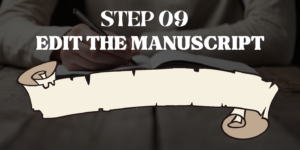
9. Edit The Manuscript
After putting all your thoughts on the paper and compiling them into an intriguing story, now it’s time to edit what you’ve written.
However, the success of any manuscript depends on its storyline and writing excellence, but a thoroughly edited book will upgrade its overall quality.
If you think that we have mentioned the book editing process just because you’re a new writer in the industry, you’re wrong. Even the best out of the best writing piece requires editing.
So, don’t feel discouraged if you find errors and mistakes in it. In the end, you will find immense satisfaction in adhering to the editing process. The outcome will be a fully polished, flawless book that is ready to outstand genre rivals.
The book editing process completes in two steps; Self-editing and Professional editing.
9a. Self- Editing
To ensure that your words entail the story you want to share with the world, start by editing and proofreading your content.
But remember!
Jump on this stage after completing the writing phase!
Read word by word and line by line with focus and dedication.
We suggest you turn on track changes in your Word document or print out the draft on the paper to make an edit. By doing this, it will become easier for you to spot mistakes and errors and enable you to make changes in your manuscript seamlessly.
Self-editing follows a precise strategy, and embarking on this journey without understanding it can be daunting. To avoid feeling overwhelmed, take the time to grasp the intricacies of the process before delving in headfirst.
Here’s how you can self-edit your book draft seamlessly;
- While editing, read your draft loudly.
- Instead of editing all at once, go chapter by chapter.
- Firstly, address structural revisions within the chapter.
- Secondly, identify areas where the book’s readability can be enhanced.
- Thirdly, fine-tune grammar and word choice.
After completing your self-edit, incorporate the revisions into your manuscript, preparing it for the next round of edits.
9b. Hire Experts For Book Editing
After completing self-editing, you can’t just sit back and think that your draft is now flawless. Now, it’s time to pass your draft to the professionals.
No matter how diligent you are, it’s inevitable to overlook some grammatical or spelling errors. Hiring a professional editor’s assistance can ensure a thorough review of your writing’s structure, providing valuable feedback that will instill confidence in your final published draft.
c. Rewrite Sections That Need Improvement
After taking assistance from the book editing experts, make changes in the areas they suggested to improve the book’s overall readability and quality.
But don’t be disheartened when your manuscript returns filled with edits, comments, and identified errors. Embrace this valuable feedback as an opportunity to enhance your writing skills.
Would you like it if your readers get a book full of grammatical mistakes and structural errors?
You only have to carefully review your editor’s feedback and make revisions that seem necessary to you.
It’s completely fine if you don’t agree with your editor on certain points. Remember, it’s your book, and you have the ultimate control over what to include or remove from the manuscript. Trust your inner feelings and make decisions that align with your creative vision.
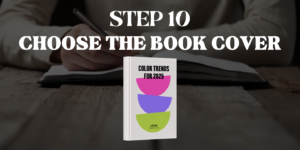
10. Choose A Compelling Book Cover
You often have heard the quote, “Never judge a book by its cover”, but this phrase only implements in our daily lives. When it comes to book writing, people do judge a book by its cover.
According to several studies, up to 80% of readers initially get attracted towards the book due to its cover. Moreover, up to 60% of people make their purchasing decisions, even after reading the back cover, based on the visual appeal and design of the book’s cover.
You can hire freelance graphic designers to design enticing book covers for your book or take assistance from the professionals available on online book designing platforms to come up with something new for you.
Here are some of the things you should consider when choosing a design for your book cover:
- Reflect Your Story. Your book cover should provide a visual glimpse into the essence of your story, captivating potential readers and conveying its genre and tone.
- Simplicity With Impact. Balance eye-catching design with simplicity to avoid overwhelming visuals that might distract from the message.
- Choose The Right Typography. Select fonts that complement your genre and resonate with your target audience.
- Test And Iterate. Gather feedback from your network to refine your book cover design, ensuring it resonates with your readers.
- Consistency Across Formats. Create a cover that looks great in both print and digital formats to cater to all readers.
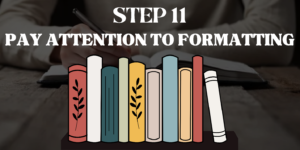
11. Pay Attention To Book Formatting
After completing the manuscript, now is the time to give your book the final shape through detailed formatting. It’s an essential bridge that transforms your raw manuscript into a polished masterpiece, ready to captivate readers.
But keep in mind that an effectively formatted book ensures that text remains intact, with no cut-offs, incorrect indentations, or typesetting errors.
These are intricacies you should focus on when formatting your book.
- Ensure Consistency. Establish a uniform style for fonts, headings, and paragraph spacing throughout your book, creating a seamless reading experience.
- Organize With Finesse. Divide your content into well-structured chapters and sections, guiding readers on a smooth literary adventure.
- Focus on Page Layout. Set margins, headers, footers, and page numbers with precision, harmonizing aesthetics, and functionality.
- Multi-Platform Mastery. Prepare your formatting for both print and digital editions, ensuring your book shines in every format.

12. Publish Your Book
To publish your book, you have to first decide whether you want to publish your book online or want it as a print book. However, both options have their own perks and limitations.
Self-publishing your book online is a rigorous and tiring process. So, hiring someone to do it for you is a better option. It will also change depending on which self-publishing platform you want to work with. Some of the most trusted platforms include IngramSpark, Amazon, Lulu, and others.
Once you’ve clicked the “publish” button on your chosen platform, it’s time to put your launch and marketing strategies into action. In the next section, we’ll delve into these crucial steps to help you effectively promote your book and reach your target audience.
Final Thoughts
In conclusion, writing a book is a multifaceted journey that requires a plethora of skills and a willingness to learn. The steps outlined here provide a starting point for aspiring writers, but the learning process is ongoing.
Countless successful authors have blazed the trail before you, offering valuable insights and proven techniques. However, the ultimate responsibility lies in discovering your own unique style and process that resonates with you.
The realm of writing is ever-evolving, and every author, regardless of the scale of their work, possesses unique experiences worth sharing with others. Keeping this in mind, start your book writing journey, and remember that through perseverance and dedication, you can carve your path to becoming a proficient and impactful writer.

 Last Updated: January 26, 2024
Last Updated: January 26, 2024

 Last Updated: January 26, 2024
Last Updated: January 26, 2024

 Last Updated: January 24, 2024
Last Updated: January 24, 2024

 Last Updated: January 23, 2024
Last Updated: January 23, 2024

 Last Updated: January 22, 2024
Last Updated: January 22, 2024


 Last Updated: January 22, 2024
Last Updated: January 22, 2024

 Last Updated: January 20, 2024
Last Updated: January 20, 2024

 Last Updated: January 20, 2024
Last Updated: January 20, 2024


 Last Updated: January 18, 2024
Last Updated: January 18, 2024

 Last Updated: January 18, 2024
Last Updated: January 18, 2024

4,482
Share
How to Write A Book: An Ultimate Guideline
I Want To Write A Book But Don’t Know How To Get Started?
Well, we all have once thought about writing a book after reading J.K Rowling’s fantasy masterpiece “Harry Potter” or Sidney Sheldon’s “The Other Side of Midnight?”
But writing a book isn’t as simple as sitting on the comfy couch in your living room, grabbing the pen and paper, and boom! You’ve carved the next literary masterpiece of the world.
So, what’s actually the secret formula to crack your creative side and write a book that will keep your audience hooked from the beginning till the end? Well, there’s no unique cheat sheet through which you can walk on the lucrative path to authorship.
For some, the gentle hum of a quiet room and the aroma of a freshly brewed cup of coffee creates the perfect atmosphere for writing, while other find their creative powers awakened amidst the embrace of nature.
In this blog post, learn the art of writing a literary masterpiece and becoming the next big author. So, let’s get started.
Table of Content
12 Steps To Write A Book
As book writing guide is an extensive topic, we have divided this process into three sections;
Step 01:Pre-Planning Phase
1. Prepare Yourself For Writing
Writing a book is no less an art, and turning an ordinary art into an exceptional masterpiece takes time, dedication, and hard work. It takes nothing to idolize a renowned bestselling author like Stephen King or Octavia Butler. However, every individual has a unique story of starting as an ordinary person and overcoming challenges to reach their current position.
For instance:
Octavia E. Butler juggled multiple jobs to support herself while dedicating early mornings to writing. Undeterred, she penned success mantras to fuel her determination.
Stephen King worked various jobs as a janitor and gas pump attendant. After the rejection of his first novel, Carrie, by 30 publishers, he discarded the manuscript but later found success with its publication, launching his illustrious writing career.
So, what have we learned?
The first step to learning book writing is understanding how to overcome writer’s block, deal with self-doubts, and put yourself in a productive mind frame to help you achieve your goals.
You can work on these two practices to overcome obstacles and crush challenges to keep you directed towards achieving your goal- writing a book.
1a. Be Accountable For Your Writing
Do you only write when you have nothing else to do? If yes, you can’t become a successful author and reap name and fame in the writing world. It’s not a good practice to write only when you feel inspired.
Approach your writing with the same commitment as a job or responsibility. Hold yourself accountable, take consistent action, and show up daily to make progress.
1b. Set Up The Writer’s Mindset
Obviously, we are talking about book writing, but what does it mean to set up the writer’s mindset?
Well, that doesn’t mean that you need to recite a specific mantra to transport yourself to another world of book writing or give you the superpower to write perfectly everything that comes into your mind.
Many inspirational authors stay stuck in the middle of the plot because of their mindset, which prohibits them from coming up with something creative.
Here’s how to set up your mindset as a writer;
Additionally, seeking out experienced writers or professionals within your circle can provide valuable mentorship.
Engaging in conversations with them about your endeavors, progress, and writing challenges can lead to fresh perspectives and improved solutions, ultimately enhancing your writing style.
2. Choose A Good Writing Space
Choosing a perfect spot where you can lean back and pen down your manuscript is as important as choosing the right title for the book.
Yes! You heard it right.
Your surroundings and where you sit have a great influence on what you write.
But it’s not necessary that this perfect writing spot should be in your home. If you don’t find the motivation to write in your home, you can go for other options like a coffee shop, a co-working space, a library, a park, or any other place where you can write your best.
Working from home is the best option, but it may be a hurdle if you have kids or family members around or simply don’t have any assigned room in your home.
The truth is that the ideal writing environment is unique and subjective to every individual. We all give our best in different environments. Maybe experienced writers can pen down their best in co-working spaces, and one who is new to writing prefers to work in a calm environment.
If you don’t know which one is the best for you, we suggest you experiment to find out the best setting where you can write freely with focus.
How does an ideal writing space look like?
Try working in different locations to determine in which setting you can give your best. It’s possible that you’ll find yourself tapping into your creativity more effectively by periodically changing your writing environment.
Here are some valuable pointers to help you establish an atmosphere that fosters concentration and boosts your writing output:
3. Find Out What People Are Reading
Before writing a book, it is essential to conduct market research on Amazon to identify the most popular books in your genre. Keep in mind that if you want your book to thrive, you must compete with these bestsellers. To do this, go to the Amazon Best Sellers page and locate your genre using the left-hand sidebar.
Next, analyze the blurbs of those books to discern the key selling points. Identify common elements that make them appealing to readers. Evaluate whether your book meets these criteria.
Lastly, brainstorm how your book can bring something fresh and unique to the table. Consider what innovative aspects or perspectives it can offer to stand out from the existing competition.
For instance, if you’re planning to write an adventurous story, determine whether your story will feature a daring and resourceful protagonist who embarks on thrilling journeys or a series of unexpected twists that keep the reader engaged and eager for more.
In today’s hyper-competitive market, pushing the boundaries is essential to give your book a real shot at success. So, don’t skimp on conducting extensive research within your genre before starting writing.
This will provide valuable insights into the standards you need to meet and how you can surpass them to make your book shine in the teeming market.
4. Select The Software For Book Writing
After the revolution of the internet, nothing has remained the same. Not even the book writing!
It all started in 1882 when Mark Twain sent his first manuscript to the publisher that had been written on the leaf of technology, a typewriter, which ultimately transformed the entire writing industry.
Fast forward, now in 2023, we have numerous advanced tools and applications to carve the best piece of writing for the readers.
From novice word processing software to thousands of AI tools, we have access to almost everything around the world. You can get your hands-on endless book writing applications that can assist you in becoming a renowned name in the industry.
Instead of confusing you by entailing different applications available on the internet, below is the list of four free online tools that we recommend to all potential writers to add to their writing toolkit today.
Instead of overwhelming you with all the possible apps in existence, below is a list of five tools I recommend adding to your writing toolkit today (and they’re free).
4a. Google Drive
4b. Chat GPT
Since its debut in November 2022, Chat GPT has brought about significant transformations in the digital marketplace.
While the premium version of Chat GPT unlocks its full potential, the free version remains an invaluable resource for gaining basic insights and grasping the essence of various topics.
4c. Grammarly
Grammarly offers a free version of its editing tool that provides valuable assistance in enhancing your writing.
With this version, you can improve your grammar, punctuation, and spelling, as well as receive suggestions for sentence structure and word choice.
It scans your text for errors, highlights them, and offers alternative corrections, helping you avoid embarrassing mistakes.
Additionally, Grammarly provides explanations for its suggestions, helping you learn from your errors and become a better writer over time.
While the free version offers significant benefits, Grammarly also offers a premium subscription with advanced features such as plagiarism detection, style improvements, and vocabulary enhancement, further enhancing the quality of your writing.
4d. Evernote
Evernote proves to be an invaluable tool for book writers. With its versatile features, you can easily gather and organize your research materials, outline chapters, and jot down plot ideas on the go.
The ability to sync across devices, including Google Docs, ensures that your work is always accessible and up-to-date.
Whether you’re a professional author or an aspiring writer, Evernote provides the essential support to streamline your book writing process and bring your literary visions to life.
4e. A Notebook & Pen
Don’t underestimate the power of using pen and paper for writing a book. It’s unarguably the most important writing tool, even in 2023.
Even if you use a writing software program for your entire manuscript, it’s still important to have a notebook on hand for those moments when inspiration hits, and you don’t have access to a computer.
Every writer should keep a notebook handy for capturing random ideas and thoughts. You can quickly write them down in your notebook and later transfer them to your digital writing software when you’re back at your computer.
Step 02.Book Writing Phase
5. Get Started With An Intriguing Book Idea
After doing all the pre-planning, the next phase is coming up with an engaging idea for your book. If you don’t have one, you won’t be able to write more than a few lines.
That means everything starts with an idea.
So, what’s your idea?
Perhaps you have a clear vision of what you want to write about, or maybe your mind is filled with numerous ideas, but you’re unsure where to begin.
If you don’t have one, you can come up with one by questioning yourself on these grounds;
By considering and responding to these questions, you can narrow down your choices to determine the most suitable options for you.
Whether you’re crafting a practical non-fiction guide or weaving a captivating post-apocalyptic thriller, it’s crucial to establish a connection with your audience, and one effective way to achieve that is through evoking emotions. To truly resonate with your readers, it’s essential to gain a deep understanding of them.
For instance: The scenario where you find yourself with numerous book ideas, yet there’s only one that genuinely ignites your passion and confidence. That very idea becomes your premise.
On the other hand, if you find yourself devoid of ideas, the questions mentioned questions will guide you towards a more definite path. Focus on the genres and books that captivate you, those that have left a profound imprint on your being. Chances are, you’ll write a book within a similar realm.
By focusing on these four factors, you can determine better what you want to write and how to do it more clearly;
5a. Write About Things That Interest You
Find a title that ignites your curiosity, a topic that entices you to return consistently, or come up with something that captures your deep interest, a subject in which you are fully engaged.
If you’ve chosen something that doesn’t interest you or just because it’s trending and everybody is talking about it, there are very few chances that you can write something that can appeal to your readers.
Choose a topic that sustains your motivation even during periods of zero inspiration or when faced with writer’s block. Your chosen subject should be the one that propels you forward and keeps you committed to the creative process.
5b. Identify Your Target Audience
Another key factor that will impact your topic choice is your targeted reader. One effective approach is to develop a reader persona, a partially fictional representation of your ideal audience.
This persona serves as a guiding archetype, helping you tailor your content to resonate with and engage your intended readership.
To embark on the journey of crafting your reader persona, start by answering the following questions;
Long story short, the more you try to understand readers, the better writing you can deliver to them.
5c. Choose Topics On Which You Can Immediately Write
The process of writing and completing a book is no less than a life-long experience for any author. There will come a time when you are able to write at your best, but there may also be instances when you find yourself struggling with a particular topic. If you’re unsure of where to start, it’s advisable, to begin with the topic you are most knowledgeable about. We recommend selecting a title that allows you to write quickly and efficiently, even with limited resources.
Let’s explore some ways to discover a topic on which you can write immediately;
5d. Research Potential Topics
In this tech era, finding a relevant topic for your book has now become a matter of just a few clicks.
Write a keyword or idea on the search bar and Ta-Da! You got thousands of suggestions for your new book.
Search engines like Google and Bing have now made it easier to research any topic.
But wait! Do you have too many ideas for your book? You can also skim and scan each one to determine its scope.
Let’s find out some of the ways through which you can research the book idea on Google;
Check out the content that has already been written in other books of the same genre.
6. Outline The Story
Just like architects come up with blueprints before constructing any building to visualize its appearance upon project completion, creating a remarkable story requires the development of a flawless outline.
If you want to pen down an interesting story, you must have an intriguing outline in hand first. Having a solid blueprint is particularly crucial, especially for first-time authors, as it serves as a reliable guide to navigate through challenging moments when writer’s block inevitably strikes. (And trust us, it will.)
Let’s find out how we can create a book outline that you can use as a map to seamlessly write a complete book.
6a. Come Up With A Mind Map
Once you grasp an idea, now is the time to implement what’s on your mind. With a perfect mind map for your book, you can better drill down into its sub-topics.
Here’s how you can list down ideas for your book;
After idea mind mapping, you’ll definitely have a page full of brainstormed concepts, ideas, and thoughts. Review your writing and start organizing it according to your priority or book flow. These pointers will help you a lot when you start writing content for the book outline.
6b. Pen Down A Purpose Statement
Try to define the book’s purpose in a sentence or two. A compelling purpose statement will clarify to readers the reasons they should contemplate reading your book.
Additionally, this will aid in maintaining focus as you embark on drafting your outline and writing your book and prevent you from deviating into unrelated topics or going off on tangents.
6c. Create A Preliminary Outline For Your Book
Finally, it’s time to draft a working outline for your book. But remember, it’s just a basic task; this outline may vary throughout the writing procedure, and that’s perfect.
Commence by integrating the sub-topics and ideas you’ve noted in your mind map into your book’s outline.
Your outline will prove invaluable once you begin writing. It can effectively combat writer’s block and boost your writing momentum and productivity. Instead of pondering what to write in the next chapter of your book, you’ll already have a clear starting point from your book’s outline.
6d. Fill In The Writing Potholes With Extensive Research
Once you’ve finished your working outline, it becomes crucial to conduct further research on your topic. This step will enable you to fill in any gaps or areas you might have missed or overlooked in your initial outline.
Ensure a balance between research and writing. Dedicate time to research, but avoid becoming overly absorbed in it, as it could impact your book writing journey.
Here’s how you can research while writing a book;
6e. Guidelines For Crafting Your Book
Adopting a framework for your book can significantly facilitate keeping your writing organized and relevant.
Selecting a format or structure that aligns with your book’s topic will prove invaluable in creating a cohesive outline, and streamlining the writing process for each chapter.
These are things you should keep in mind while writing your outline.
6f. Frameworks
Within the vast landscape of Book Writing, there exist numerous molds into which you can shape your book. However, here are some of the preferred frameworks, specifically suited for non-fiction writing, that you may consider when starting your book-writing journey:
Step 03: Final Touch-Up Phase
7. Pen Down The Book Draft
After passing through all the preliminary planning stages, generating ideas through brainstorming, and crafting a detailed outline, now is the time to step into the real battlefield; writing down the first book draft.
Being first-time authors, we understand that it’s difficult to come up with perfect plots and ideas in one go, but Rome wasn’t built in a day.
Several novice writers believe that writing a compelling masterpiece is all about awe-inspiring verbiage, figurative language, and intricately woven sentences.
But that’s not true!
If that’s the case, “To Kill a Mockingbird” by Harper Lee won’t become a bestseller in 1960. Even this is the book that has been loved by readers to this date.
However, the style holds great importance; subject matter is far more essential in book writing. That means; paying attention to tone and vocabulary but plot, character, themes, and climax should be your primary priority.
7a. Come Up With An Intriguing Opening Sentence
But, sometimes, writers face difficulty not in writing an intriguing introduction that keeps the reader on the tip of their toes but an end that leaves a lasting impression lingering in the reader’s mind long after they have turned the final page.
Crafting a satisfying conclusion that ties together all the narrative threads and delivers a powerful message can be a formidable challenge.
Let’s find out some of the most reliable tips that you can follow to complete your book;
With the book’s outline and chosen framework at hand, you are all set to start writing your first manuscript.
When you focus on the bigger picture of book writing, there’s a huge possibility that you might get overwhelmed in the early stages of writing.
Here are some of the ways through which you can better breakdown your book writing into smaller sections;
Alternatively, if you choose to divide your writing time into three separate periods throughout the day, you can allocate your dedicated hours as follows:
Celebrate Small Achievements: Small victories lead to big wins! That’s why we suggest you celebrate every milestone you achieve in book writing, no matter how small or big it is. Be it going out for dinner, treating yourself with coffee and cookies, buying yourself a fancy pan, or anything else you love.
7b. Buckle Up Your Shoes To Complete Your Book
Creatively penning down something is not a walk in the park, and when it comes to book writing, the situation becomes even more challenging.
We don’t promise that your book writing journey will be without challenges, nor do we guarantee that with our tips, you’ll complete a 260-page book within a mere month.
There will also come a time when you may encounter moments of writer’s block. Even when you have a clear idea of what you should be writing, there will be times when the words sound amiss as you reread and assess your work in your mind.
But don’t worry! That’s normal!
We have bought some tips that can help you fight with creative block and speed up your writing process;
Avoid Editing While Writing: Editing and writing are two different skill sets that require you to work in two different mind frames. It’ll slow down your writing pace and make you stop at different points.
So, Write First And Edit Later.
Don’t stress if your initial writing isn’t flawless; the primary goal is to express your thoughts. You can polish and refine your words during the editing process.
7c. Craft A Book That’s Pure Thrill And No Frills
Writing a book is no less than a challenge, especially when you reach a section with vague outlines. Yes, it looks tempting to add excessive words and fancy techniques to fill the page. However, that’s just filler content. If you add too much of it in your book, readers may get frustrated and perceive you as trying too hard to impress.
Outlining is one of the effective ways to do it, but here are a few more tips through which you can outstand your storyline;
Kurt Vonnegut says that if a sentence fails to achieve either of these objectives, consider removing it. If the passage remains coherent and meaningful, then it’s best to let it go.
8. Come Up With A Book Title
The words that matter the most for your book are the ones gracing the outside cover.
Your Book Title!
If 90% of your target audience reads your book’s title, there are chances that 25% will buy and read your book. Given this, it becomes crucial to invest additional effort in crafting an emotionally compelling and impactful title.
Create a title that not only sticks in the minds of readers but also vividly portrays the genre and storyline of your book. Make it easy for potential readers to recall and be intrigued by what your book has to offer.
Prepare a comprehensive list comprising ideally 25 or more titles. This abundance of options will offer you the freedom to mix and match, enabling you to discover the perfect title that captures the essence of your story.
Topic Suggestions For Fiction
When crafting a book title for a fictional genre, opt for titles that vividly portray the story’s characters, encompass engaging catchphrases, and hint at the captivating twists woven throughout the book.
Let’s explore examples of titles that already exist in the marketplace;
Your book’s title for the fictional genre;
Topic Suggestions For Non-Fiction.
When choosing a book title for the non-fiction genre, take into consideration the concerns and interests of your target audience and how your book aims to address them.
Despite being rooted in reality, non-fiction titles can still embrace creativity and originality, offering readers a clear understanding of the book’s subject matter and purpose.
Make sure your title serves as an enticing gateway, inviting readers to explore the valuable knowledge and insights within your non-fiction work.
That means; your book’s title for the non-fictional genre;
9. Edit The Manuscript
After putting all your thoughts on the paper and compiling them into an intriguing story, now it’s time to edit what you’ve written.
However, the success of any manuscript depends on its storyline and writing excellence, but a thoroughly edited book will upgrade its overall quality.
If you think that we have mentioned the book editing process just because you’re a new writer in the industry, you’re wrong. Even the best out of the best writing piece requires editing.
So, don’t feel discouraged if you find errors and mistakes in it. In the end, you will find immense satisfaction in adhering to the editing process. The outcome will be a fully polished, flawless book that is ready to outstand genre rivals.
The book editing process completes in two steps; Self-editing and Professional editing.
9a. Self- Editing
To ensure that your words entail the story you want to share with the world, start by editing and proofreading your content.
But remember!
Jump on this stage after completing the writing phase!
Read word by word and line by line with focus and dedication.
We suggest you turn on track changes in your Word document or print out the draft on the paper to make an edit. By doing this, it will become easier for you to spot mistakes and errors and enable you to make changes in your manuscript seamlessly.
Self-editing follows a precise strategy, and embarking on this journey without understanding it can be daunting. To avoid feeling overwhelmed, take the time to grasp the intricacies of the process before delving in headfirst.
Here’s how you can self-edit your book draft seamlessly;
After completing your self-edit, incorporate the revisions into your manuscript, preparing it for the next round of edits.
9b. Hire Experts For Book Editing
After completing self-editing, you can’t just sit back and think that your draft is now flawless. Now, it’s time to pass your draft to the professionals.
No matter how diligent you are, it’s inevitable to overlook some grammatical or spelling errors. Hiring a professional editor’s assistance can ensure a thorough review of your writing’s structure, providing valuable feedback that will instill confidence in your final published draft.
c. Rewrite Sections That Need Improvement
After taking assistance from the book editing experts, make changes in the areas they suggested to improve the book’s overall readability and quality.
But don’t be disheartened when your manuscript returns filled with edits, comments, and identified errors. Embrace this valuable feedback as an opportunity to enhance your writing skills.
Would you like it if your readers get a book full of grammatical mistakes and structural errors?
You only have to carefully review your editor’s feedback and make revisions that seem necessary to you.
It’s completely fine if you don’t agree with your editor on certain points. Remember, it’s your book, and you have the ultimate control over what to include or remove from the manuscript. Trust your inner feelings and make decisions that align with your creative vision.
10. Choose A Compelling Book Cover
You often have heard the quote, “Never judge a book by its cover”, but this phrase only implements in our daily lives. When it comes to book writing, people do judge a book by its cover.
According to several studies, up to 80% of readers initially get attracted towards the book due to its cover. Moreover, up to 60% of people make their purchasing decisions, even after reading the back cover, based on the visual appeal and design of the book’s cover.
You can hire freelance graphic designers to design enticing book covers for your book or take assistance from the professionals available on online book designing platforms to come up with something new for you.
Here are some of the things you should consider when choosing a design for your book cover:
11. Pay Attention To Book Formatting
After completing the manuscript, now is the time to give your book the final shape through detailed formatting. It’s an essential bridge that transforms your raw manuscript into a polished masterpiece, ready to captivate readers.
But keep in mind that an effectively formatted book ensures that text remains intact, with no cut-offs, incorrect indentations, or typesetting errors.
These are intricacies you should focus on when formatting your book.
12. Publish Your Book
To publish your book, you have to first decide whether you want to publish your book online or want it as a print book. However, both options have their own perks and limitations.
Self-publishing your book online is a rigorous and tiring process. So, hiring someone to do it for you is a better option. It will also change depending on which self-publishing platform you want to work with. Some of the most trusted platforms include IngramSpark, Amazon, Lulu, and others.
Once you’ve clicked the “publish” button on your chosen platform, it’s time to put your launch and marketing strategies into action. In the next section, we’ll delve into these crucial steps to help you effectively promote your book and reach your target audience.
Final Thoughts
In conclusion, writing a book is a multifaceted journey that requires a plethora of skills and a willingness to learn. The steps outlined here provide a starting point for aspiring writers, but the learning process is ongoing.
Countless successful authors have blazed the trail before you, offering valuable insights and proven techniques. However, the ultimate responsibility lies in discovering your own unique style and process that resonates with you.
The realm of writing is ever-evolving, and every author, regardless of the scale of their work, possesses unique experiences worth sharing with others. Keeping this in mind, start your book writing journey, and remember that through perseverance and dedication, you can carve your path to becoming a proficient and impactful writer.
Table of Content